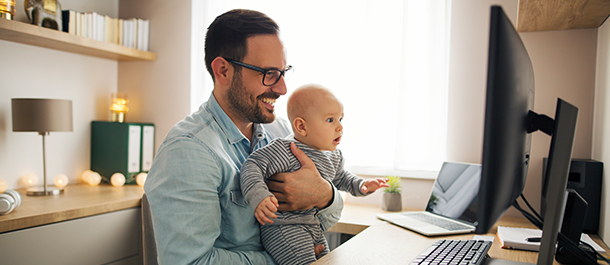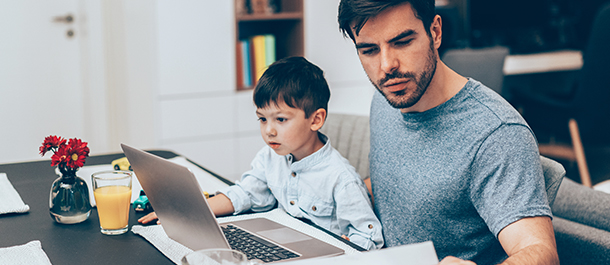Home. The New Office and Classroom

Prior to the COVID-19 outbreak, working and learning from home provided an occasional solution to getting the job done or school day completed in a pinch. Today reinventing home space into makeshift offices and classrooms has become the norm for parents and students throughout the country. But don’t worry, with a little time, thought and creativity any home can be adapted to provide a suitable environment for working and learning.
If you are lucky enough to already have a designated office space in your home, you are one step ahead of the curve. But, you may still need space for other family members or children to set up shop.
Whether it be a bedroom, guest room, dining room or kitchen counter, here are some helpful tips to transform ordinary spaces in your home into efficient workspaces:
Find the Right Space

- Be innovative by transforming unused areas into workspaces. The corner of a living room or den can provide a cozy spot for a small desk; or try replacing a nightstand in the bedroom with a small folding table.
- Take advantage of areas with double duty. The kitchen or dining room table or island easily converts into a desk and can be used by more than one adult or child. How about using the coffee table in the living room or den as a desk, and the couch for seating. Need to elevate the computer? A stack of books underneath offers the perfect solution.
- If space is limited finding a way to arrange each family member in their own designated space can be challenging, but they key is to create as much privacy as possible. On nice days someone can work outside on a picnic table, or perhaps spread a blanket on the grass for the kids.
Stay Organized

- Keep electrical cords organized and neat by using zip ties.
- Find efficient places for everyone to charge electronic devices by replacing standard outlets in the living room, kitchen and bedrooms with USB Outlets. With both USB charging ports and traditional outlets in one device, it’s the perfect way to keep everyone charged and connected and have outlet space available to plug in other electronics like printers, lamps, etc.
- Use baskets, bins, drawers, or roll away storage to keep work/school papers and supplies together in one place… and away from the family dog who really just may eat it!
Proper Lighting

- Take advantage of natural sunlight by keeping shades and blinds open.
- Consider automating your lights by installing voice activated lighting control with Amazon Alexa built-in. Not only will you be able to dim and turn lights on and off with your voice, you can also ask the weather, get the news, stream music and much more without leaving your desk.
- Install dimmers to easily raise or lower light level. It’s the perfect solution for managing lighting to control glare on computer and tablet screens.
- Invest in desk lamps. They come in especially handy for students working in the same room so each can manage their own lighting.
Ergonomics

- A makeshift desk and chair are fine for a day but for the longer term we all need to consider proper ergonomics to increase productivity and reduce stress and discomfort on the body.
- The correct chair height, monitor distance, and proximity to frequently needed supplies is paramount for a healthy work and study environment. To avoid a large financial investment, you can use common household items such as pillows to sit on and books or boxes placed under laptops for elevation.
Maintain a Routine

- Create and stay on a schedule. This is especially important in households with children to maintain sanity. Begin by designating daily start/stop times, lunch/snack breaks, and short exercise breaks to stretch your legs and take your eyes off your monitor. This can be a walk during lunch, intermittent walks around your house or a few trips up and down the stairs every hour or so.
- Helpful tip - use a timer to stay on schedule.
- Get dressed, don’t stay in pajamas all day. You’ll feel more energized and in “work mode”.
Add Personality and Ambiance to Your Space

- Working is more enjoyable and productive in a pleasant environment. Be sure to include things you love at your workstation. Fresh flowers, a green plant, pictures of loved ones, a favorite paperweight or souvenir can make your space feel more inviting.
- Don’t forget the kids. A little pizazz like hanging a favorite poster or some of their own drawings goes a long way.
It may be a while before things get back to normal, so taking time to create designated work and study spaces is a must. Don’t get overwhelmed, get creative and make it a fun project for the entire family!


